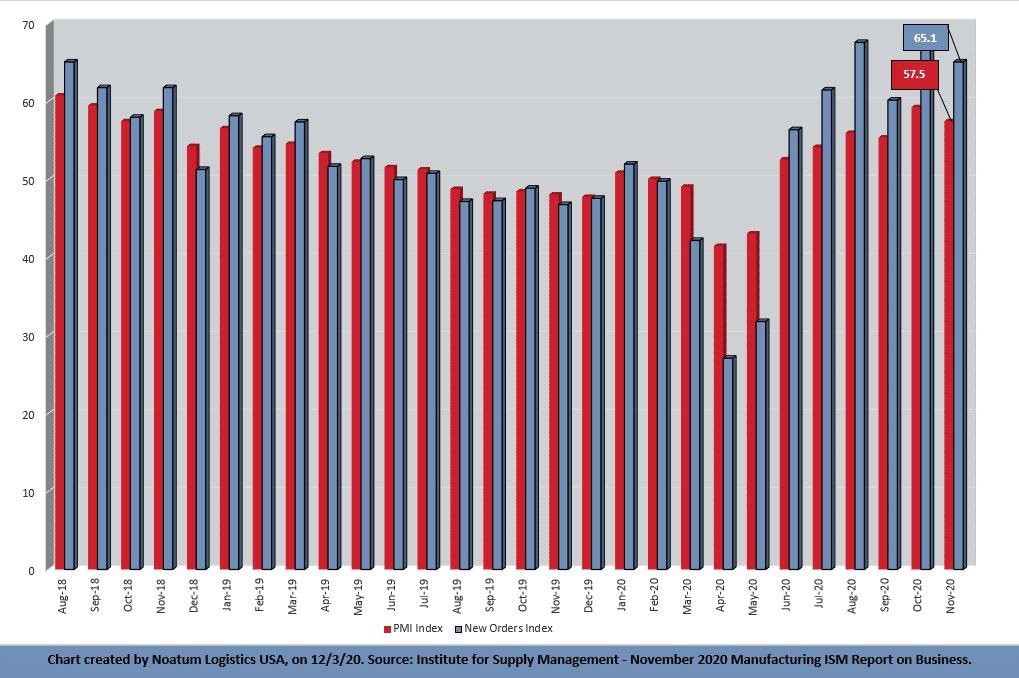Source: Institute for Supply Management – December 2, 2020
Economic activity in the manufacturing sector grew in November, with the overall economy notching a seventh consecutive month of growth, say the nation’s supply executives in the latest Manufacturing ISM® Report On Business®.

The report was issued today by Timothy R. Fiore, CPSM, C.P.M., Chair of the Institute for Supply Management® (ISM®) Manufacturing Business Survey Committee:
“The November Manufacturing PMI® registered 57.5 percent, down 1.8 percentage points from the October reading of 59.3 percent. This figure indicates expansion in the overall economy for the seventh month in a row after a contraction in April, which ended a period of 131 consecutive months of growth. The New Orders Index registered 65.1 percent, down 2.8 percentage points from the October reading of 67.9 percent. The Production Index registered 60.8 percent, a decrease of 2.2 percentage points compared to the October reading of 63 percent. The Backlog of Orders Index registered 56.9 percent, 1.2 percentage points higher compared to the October reading of 55.7 percent. The Employment Index returned to contraction territory at 48.4 percent, 4.8 percentage points down from the October reading of 53.2 percent. The Supplier Deliveries Index registered 61.7 percent, up 1.2 percentage points from the October figure of 60.5 percent. The Inventories Index registered 51.2 percent, 0.7 percentage point lower than the October reading of 51.9 percent. The Prices Index registered 65.4 percent, down 0.1 percentage point compared to the October reading of 65.5 percent. The New Export Orders Index registered 57.8 percent, an increase of 2.1 percentage points compared to the October reading of 55.7 percent. The Imports Index registered 55.1 percent, a 3-percentage point decrease from the October reading of 58.1 percent.”
Fiore continues, “The manufacturing economy continued its recovery in November. Survey Committee members reported that their companies and suppliers continue to operate in reconfigured factories, but absenteeism, short-term shutdowns to sanitize facilities and difficulties in returning and hiring workers are causing strains that will likely limit future manufacturing growth potential. Panel sentiment, however, is optimistic (2.5 positive comments for every cautious comment), an improvement compared to October. Demand expanded, with the (1) New Orders Index growing at strong levels, supported by the New Export Orders Index expanding strongly, (2) Customers’ Inventories Index at its lowest figure since June 2010 (35.8 percent), a level considered a positive for future production, and the (3) Backlog of Orders Index expanding at a slightly faster rate compared to the previous three months. Consumption (measured by the Production and Employment indexes) contributed negatively (a combined 7-percentage point decrease) to the Manufacturing PMI® calculation, with five of the top six industries continuing with moderate to strong output expansion. The Employment Index contracted after a single month of growth, primarily due to the inability to attract and retain direct labor. Inputs — expressed as supplier deliveries, inventories and imports — continued to indicate input-driven constraints to production expansion, at higher rates compared to October, as indicated by minimal gains in inventory levels and a softening of imports. Input improvement stalled compared to October and contributed marginally to the Manufacturing PMI® calculation. (The Supplier Deliveries and Inventories indexes directly factor into the Manufacturing PMI®; the Imports Index does not.) Prices continued to expand at higher rates, reflecting a clear shift to seller pricing power.
“Among the six biggest manufacturing industries, five (Fabricated Metal Products; Chemical Products; Computer & Electronic Products; Transportation Equipment; and Food, Beverage & Tobacco Products) registered solid growth in November.
“Manufacturing performed well for the sixth straight month, with demand, consumption and inputs registering growth, but at slower rates compared to October. Labor market difficulties, both current and anticipated, at panelists’ companies and their suppliers will continue to dampen the manufacturing economy until the coronavirus (COVID-19) crisis ends,” says Fiore.
Of the 18 manufacturing industries, 16 reported growth in November, in the following order: Apparel, Leather & Allied Products; Nonmetallic Mineral Products; Textile Mills; Wood Products; Electrical Equipment, Appliances & Components; Fabricated Metal Products; Plastics & Rubber Products; Primary Metals; Chemical Products; Machinery; Computer & Electronic Products; Paper Products; Miscellaneous Manufacturing; Transportation Equipment; Furniture & Related Products; and Food, Beverage & Tobacco Products. The two industries reporting contraction in November are: Printing & Related Support Activities; and Petroleum & Coal Products.
Click here to access the entire release from the Institute for Supply Management website.
